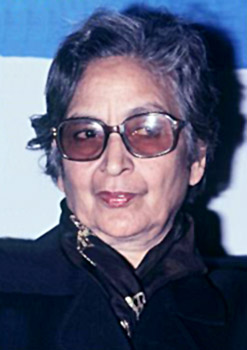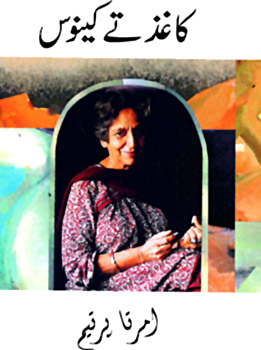 Modern Punjabi poetry is said to have emerged with the works of Mohan Singh (1905-78) and Amrita Pritam (1919). Their appearance marks the emergence of a new poetic style as a kind of revolt against the three-decade-old poetic tradition. Both Mohan Singh and Amrita Pritam struggled to devise unconventional verse patterns and to develop distinct, individual styles, though in their early writings they were influenced by the medieval Qissa tradition. The modern poets were trying to create new forms and admit new ideas as opposed to the older tradition of working along a standard medium on ideas and feelings that had already been expressed.
Modern Punjabi poetry is said to have emerged with the works of Mohan Singh (1905-78) and Amrita Pritam (1919). Their appearance marks the emergence of a new poetic style as a kind of revolt against the three-decade-old poetic tradition. Both Mohan Singh and Amrita Pritam struggled to devise unconventional verse patterns and to develop distinct, individual styles, though in their early writings they were influenced by the medieval Qissa tradition. The modern poets were trying to create new forms and admit new ideas as opposed to the older tradition of working along a standard medium on ideas and feelings that had already been expressed.
Mohan Singh
Mohan Singh stands out as one of the greatest poets of his time. He has contributed immensely to Punjabi literature with more than a dozen collections of poetry during his 50-year poetic career. His major works include Sawe Pattar (Green Leaves, 1936), Adkwate (The Midway, 1939-40), Kach Sach (Illusion and Reality, 1944-50), Awazan (The Calls, 1950-54), Wada Vela (The Dawn, 1954-58), Jandre (The Locks, 1964), and Jaimir (Long Live the Peace, 1968). In addition, he translated into Punjabi verse Matthew Arnold`s The Light of Asia and wrote Nankayan (1971), the life story of Guru Nanak in epic form to celebrate the guru`s quincentenary.
Mohan Singh sings about his personal love in his early writings, but soon his growing faith was seized by the dilemma between the social and the literary. The poet made a promising start with his early poems, which still remain popular with Punjabi readers, but in his later works, beginning with Kach Sach, he shows a strong bias in favor of progressive writing, which had become a dominant movement in the regional literature of northern India. However, his progressive ideas are not as striking or memorable as his poems that bring together personal and social themes. He himself was in a considerable dilemma over the traditional and revolutionary paths, and finally returned to the spontaneous beauty of his earlier poetry. In his Jandre and Jaimir, the last two collections of poetry, he composed a few of the finest ghazals showing a delicacy comparable to that of the Urdu ghazal (lyric). Mohan Singh was a love poet, and he sang its immortality in varied musical forms, variations, and notations.
Amrita Pritam
Amrita Pritam was another versatile poet, like Mohan Singh, who developed her poetic art in stages. She began writing poetry at a very tender age under the guidance of her father, Kartar Singh Hitkari, himself a poet and a scholar of Braj Bhasha. Her important collections of poems include her first publication, Amrit Lehran (Immortal Waves, 1936), which appeared when she was just 17, followed by Jiunda Jiwan (The Exuberant Life, 1939), Lok Peeran (The People`s Anguish, 1944), Pathar Geetey (The Pebbles, 1946), Sunehre (Messages, 1953), Ashoka Cheti (1956), Kasturi (The Musk, 1958), Kagaz te Canvas (The Paper and the Canvas, 1970), and Kala Gulab (The Black Rose, 1973). In her first book, she gave expression to her personal love in a rather traditional idiom, but later, with maturity, she became more conscious of harsh social realities around her, and her poetry turned into a commentary on immediate social and political issues.
The theme of women`s agony and shame in a male-dominated world is given a powerful voice in Amrita`s poems. The metaphor of love pervades most of her poetry collections. Without a doubt, Amrita Pritam holds a pre-eminent place in Punjabi poetry. She is the only Punjabi writer who has been honored with the Jnan Peeth Award, besides numerous national and international recognitions. She also edited a poetry magazine, Nagmani, which, over the years, had become a rallying point for many budding writers.
Both Mohan Singh and Amrita Pritam as poets have some common features. Both, in their early writing, give voice to feminist feelings in a cruel, man-dominated world. Their poetry is firmly rooted in Punjabi folk idiom. In their love lyrics, both of them draw on the oral rhythms of Punjabi folk songs and dances. Even the imagery is rural, bringing into its fold the sensitive rituals of birth, marriage, memories of paternal home, departure of a daughter from her parent`s home, pangs of separation and distant living. They also share in common images based on agricultural operations, spinning, sewing, and embroidery, the domestic chores investing their poetry with an aura of romance and realism.
Other Poets
Apart from Mohan Singh and Amrita Pritam, the two major figures, a number of other poets achieved distinction in this period. Pritam Singh Safeer (1916) wrote mystical poems using a mixture of Eastern and modern Western mystic thoughts. He has contributed to Punjabi poetry about half a dozen collections of poems, including Katak Kunjan (The Pelicans of Winter, 1941), Pap de Sohile (Appraises of Sin, 1942), and Rakat Bundan and Adi Jugad (The Beginnings, 1958). He has also written an epic on the life of Guru Gobind Singh (1991).
Bawa Balwant (1915-68), who belonged to the progressive stream of poetry, made his mark as an original and creative artist. He was profoundly influenced by Persian and Urdu poetry, as well as other contemporary, progressive writers of Urdu, and had fairly good command of Urdu prosody. He was influenced by Iqbal`s concept of "perfect man" (mard-e Kamil). In his poem "Zindgi hi Zindgi" (Life and Only Life), he gives a forceful voice to this idea of a superman. Bawa`s lyrics reflect a mystical strain. "Pippal dian Chhawan" (Shades of the Peepal Tree) is one such composition. Some of his major collections of poems are Kav Sagar (1955), Mahan Nach (1941), Amur Geet (1942), Jawala Mukhi (1943), Bandargah (1951), and Sugandh Sameer (1959).
The other poets who made their mark in this period are Avtar Singh Azad (1906-79), Piara Singh Sehrai (1915), and Santokh Singh Dhir (1920). Another tall figure, Mohan Singh Diwana (1899-1984), also made an impact on this period. Some of his well-known works include Neel Dhara (The Blue Ocean, 1935), Jagat Tamasha (The World-A Fair, 1942), Masti (Ecstasy, 1946-49), and Dhup Chhan (Sunshine and Shade, 1932).
 During the 1970s, along with the old masters, rose new poets who have shown great promise such as Harnam (1934-90), Mohanjit (1938), Tarlok Singh Kanwar (1931-94), Sutinder Singh Noor (1939), Surinder Gill (1942), Joga Singh (1942), Harbhajan Halwaravi (1943), Minder (1944), Surjit Pattar (1945), Parmindejit (1944), Manjit Tiwana (1947), Awtar Singh Pash (1950-88), Santokh Singh Shehar Yar (1947), Ravinder (1946), S. Balwant (1946), Savinderjit Savi (1947), Ravinder Bhathal (1946), Ajaib Hundal, and Gian Singh Sandhu (1936). They have shown not only a deep social awareness but also intellectual and artistic maturity in the small body of their best work. Pattar`s Hawa vich likhe Harf (The Words Scribbled in Air), Likhtam Parminderjit (Parminderjit Writes), and Uneenda Vartman (Sleepless Present) have rightly been deemed first-rate poetry. Pattar, a master of the form of ghazal, not only is aware of surrounding realities but also possesses a fine poetic sensibility for the beauty and import of the word. Irony and a highly delicate and sensuous imagery, along with lyricism, lend his poems a rare charm. Surjit Pattar, as well as Manjit Tiwana, are both recipients of the coveted Sahitya Akademi Awards.
During the 1970s, along with the old masters, rose new poets who have shown great promise such as Harnam (1934-90), Mohanjit (1938), Tarlok Singh Kanwar (1931-94), Sutinder Singh Noor (1939), Surinder Gill (1942), Joga Singh (1942), Harbhajan Halwaravi (1943), Minder (1944), Surjit Pattar (1945), Parmindejit (1944), Manjit Tiwana (1947), Awtar Singh Pash (1950-88), Santokh Singh Shehar Yar (1947), Ravinder (1946), S. Balwant (1946), Savinderjit Savi (1947), Ravinder Bhathal (1946), Ajaib Hundal, and Gian Singh Sandhu (1936). They have shown not only a deep social awareness but also intellectual and artistic maturity in the small body of their best work. Pattar`s Hawa vich likhe Harf (The Words Scribbled in Air), Likhtam Parminderjit (Parminderjit Writes), and Uneenda Vartman (Sleepless Present) have rightly been deemed first-rate poetry. Pattar, a master of the form of ghazal, not only is aware of surrounding realities but also possesses a fine poetic sensibility for the beauty and import of the word. Irony and a highly delicate and sensuous imagery, along with lyricism, lend his poems a rare charm. Surjit Pattar, as well as Manjit Tiwana, are both recipients of the coveted Sahitya Akademi Awards.
Jhujarvadi or Nakasalvadi verse in Punjabi Literature
Whereas in the pre-partition Punjab literature the Sikh revivalist movement remained dominant in spite of pressure from the progressive movement starting in the early 1940s, after independence, Punjab literature under the impact of pragtivadis brought into fore the themes of revolution, violence, death, and devastation. This continued until the early 1960s. In the late 1960s and early 1970s, the naxalite movement in Bengal was at its peak. It was an ultra-leftist, militant movement. The young writers from rural Punjab, often from landless peasant families, particularly from the Malwa belt, wrote fiery verses in support of revolution. Known as jhujarvadi or nakasalvadi verse, it attracted a few committed political workers who wrote verses to arouse the landless farm workers to take to arms against the big landlords. The Punjab government suppressed this movement with a heavy hand. The poets went underground, but they had the sympathy of the common people in the villages. This poetry was committed to progressive ideology, but its relationship with rural ethos was much pronounced. There is also a tendency in this poetry to reinterpret Sikh history, myths, and legends in the modem social and cultural contexts, investing Sikh lore and its traditions with new meanings. This poetry doesn`t have much poetic or intellectual maturity, but still it has considerable mass appeal. Some prominent names of this movement are Avtar Singh Pash, Lai Singh, Darshan Khatkar, and Harbhajan Halwarvi.













